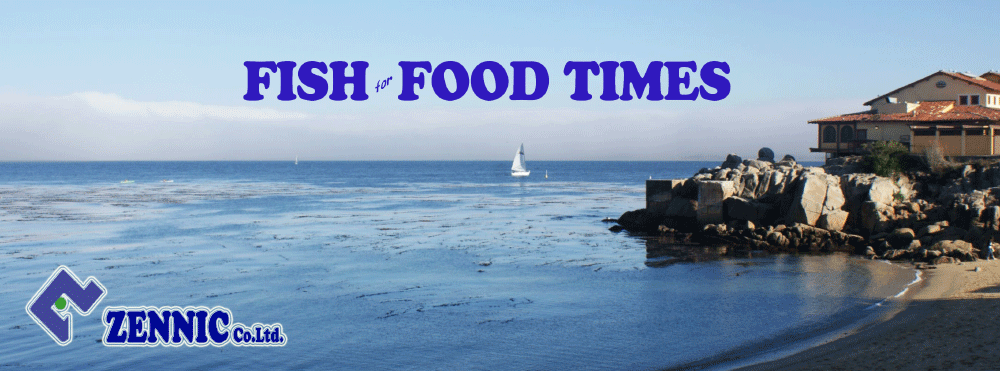Welcome to FISH FOOD TIMES
Dec. 2024 issue No.252


Japanese bluefish
Difficult to distinguish
I purchased Japanese bluefish in late November. This is not the first time I have worked with Japanese bluefish, and I have had many opportunities to do so, but I felt that the content of the images was insufficient to include them as subjects for FISH FOOD TIMES. However, this time I felt that I had gathered enough information to adequately convey the appeal of the Japanese bluefish, and so I decided to make it the theme of this month's issue.
The following images are of Japanese bluefish that I have handled in the past. Although the dates are accurate because the data is recorded, these weights are estimates based on the environment of the images, so it is best to assume that the further back in time we go, the less accurate the estimates become.

What's even more problematic is that it's unclear whether the fish in the image above is a Japanese bluefish or a gnomefish. The reason for this is that Japanese bluefish and gnomefish are not clearly distinguished at the fisheries distribution stage, and they are basically all traded under the name Kuromutsu (Japanese bluefish).
After all, the difference between Japanese bluefish and gnomefish is that the size of the scales of gnomefish is slightly larger than that of Japanese bluefish, the number of scales on the lateral line of Japanese bluefish is more than 60 while that of gnomefish is less than 58, and the number of teeth on the upper jaw of Japanese bluefish is less than 12 while that of gnomefish is more than 13. Furthermore, Japanese bluefish seems to have a darker body color than gnomefish.
However, I think everyone can understand that it is not easy for ordinary fisheries professionals to accurately distinguish between Japanese bluefish and gnomefish based on this information. It is said that even fish market experts have difficulty distinguishing between the two, and as a result, both are distributed under the name Kuromutsu (Japanese bluefish) from the fish market level to the fish retail store level.
Fillet of Japanese bluefish from Amami Oshima, Kagoshima Prefecture
In May 15 years ago, while I was instructing the fisheries department of a supermarket on Amami Oshima, I took a picture of a fish I had cooked myself.The largest fish in the image above is a Japanese bluefish, weighing about 600g. Looking back at my memory, I don't remember clearly, but I think we cut it into fillets because it didn't have much fat on it for a Japanese bluefish.
| Japanese bluefish fillet |
|---|
 |
| 1,about 600g size Japanese bluefish |
 |
| 2,Cut the fish in half lengthwise, leaving the head attached. |
 |
| 3,Cut half of the body into quarters, leaving more of the meat at the back of the head. |
From the author's experience, even though they are Japanese bluefish, they seem to have less fat in the Nansei Islands, where Amami Oshima is located, and in the Okinawa Islands further south, and the "mucchiri feeling = mutsu" that is the origin of the word mutsu seems to be weak. This may have been especially noticeable because it was May, which is the season after spawning.
Japanese bluefish nigiri sushi from Tsushima, Nagasaki
Next is approx 120g Japanese bluefish cooked on November 8, 2016. At this size, it was a young fish that was still growing, and it was an extremely fresh Japanese bluefish that had only been a few hours old since it had been landed in a set net and brought to the store. I remember that the size was so small that it was a bit of a hassle to prepare and sell it in a store, which made the price surprisingly low.
It would be inefficient to cook such small fish one by one, so I decided to cook them quickly all at once with the aim of making sushidane. Below is the work process.
| Speedy cooking of Japanese bluefish | |
|---|---|
 |
 |
| 1,about 120g Japanese bluefish | 7,Make a slight diagonal cut on the upper body up to the central bone in the same way as the lower body. |
 |
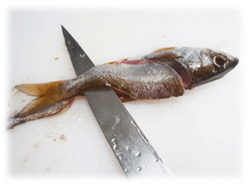 |
| 2,Without removing the scales or internal organs, use a Yanagiba knife for filleting to make a slight diagonal incision on the lower body, next to the pectoral fin, up to the central bone. | 8,Continue cutting along the central bone towards the tail fin with the yanagiba knife. |
 |
 |
| 3,Continue cutting along the central bone towards the tail fin with the yanagiba knife. | 9,When you get close to the tail fin, cut between the skin and the fish meat without cutting through the skin, and insert the tip of the knife there. |
 |
 |
| 4,
When you get close to the tail fin, cut between the skin and the fish meat without cutting through the skin, and insert the tip of the knife there. |
10,Using the uchibiki method, peel the skin all the way to the head end, separate the skin from the fish meat, then scrape off the tops of the small bones and remove the belly bones. |
 |
 |
| 5,Using the uchibiki method, peel the skin all the way to the head end and separate the skin from the fish meat. | 11,After removing all inedible parts, quickly rinse off any scales or dirt with water and remove any excess moisture. |
 |
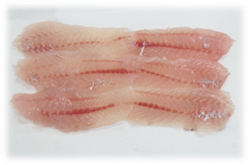 |
| 6,Scrape off the top of the small bones of the separated half body with the tip of the blade, then insert the tip of the blade under the abdominal bone and remove the abdominal bone. | 12,After removing the moisture with kitchen paper, the final step is to remove the remaining small bones. However, Japanese bluefish actually have only a few small bones near the head, and most of them have already been cut off during the preparation of the yanagiba, so you can skip the step of removing the small bones and eat it as is without even noticing the small bones in your mouth. |
 |
|
| Since the Japanese bluefish is small in size, I used the half body as a piece of sushi and commercialized it into nigiri sushi. | |
The speedy cooking method introduced here is used when cooking small, relatively inexpensive fish. It is a method that boldly omits some steps and performs them efficiently as a single flow, rather than performing each step separately - 1) removing the scales, 2) removing the internal organs, 3) separating the head, 4) three pieces disassembling, 5) skinning, and 6) removing the small bones.
This is a really quick process, but it must be done properly, as the final step is to quickly wash away any remaining inedible parts of the fish, such as scales, internal organs, and blood, and then thoroughly wipe off the water. It must be done. If this final finishing touch can be done carefully, small fish, which can likely be obtained relatively cheaply, can be turned into a product with an excellent markup.
Commercialization of Japanese bluefish purchased in Fukuoka Prefecture
On November 22nd of this year, I purchased a Japanese bluefish weighing about 250g at the fish counter of a supermarket that I frequent and am familiar with. I was in charge of consulting the seafood department at this store for about five years, and it is amazing to see that sales in the fish department this November are expected to exceed 47 million yen. Even now, the fish section is stocked with a wide variety of raw fish purchased from all over the country, including relatively minor fish such as Japanese bluefish, which are still being sold naked method. There is no need to take Kakujyo gyorui as an example. Many customers from a wide commercial area come to this store for a long time to buy fish, attracted by the wide variety of raw fish in the fish section. It seems that the number is increasing. That's why I surmised that a supermarket with an area of approximately 1,000 square meters, which is not a large scale, was able to show such high sales in the seafood section.
I bought two Japanese bluefish, each weighing about 250g, at the store. I had decided to try making these into sashimi and sushi, but the size of the fish was also suitable for grilling with salt, so I decided to grill half of the fish with salt, and prepared it as follows:
| Japanese bluefish salt-grilling work process | |
|---|---|
 |
 |
| 1,about 250gof Japanese bluefish | 7,Cut into the head with the tip of the blade, cutting it in half. |
 |
 |
| 2,After removing the scales and internal organs and wiping off the water, cut into the lower body near the anal fin, leaving the head on, and continue cutting down to the backbone. | 8,If you cannot separate the tip, apply pressure and push the tip of the knife onto the cutting board. |
 |
 |
| 3,Make a cut along the dorsal fin of the lower part of the body, and continue cutting until you reach the backbone. | 9,Cut the tip of the mouth and divide it. |
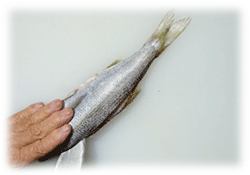 |
 |
| 4,Continue cutting above the centralbone until you reach the head. | 10,Cut off near the tail fin. |
 |
 |
| 5,Make a cut near the tail fin and pass through the top of the centralbone. | 11,The length of the tail fin is not taken into account, and the half body with the central bone on the upper side is divided diagonally in half. |
 |
 |
| 6,From the hole you just made, cut forward with the tip of the blade toward the head. | 12,Japanese bluefish products for grilling with salt |
And the grilled Japanese bluefish is shown in the image below.

My impression after eating it was "It's really delicious...it doesn't harden even when it cools down, so you can continue to enjoy the flavor."
Japanese bluefish is said to have a "high level of deliciousness as an ingredient itself," and this was felt not only when grilled with salt, but also in sashimi and sushi eaten without cooking.
Below is the process for making Japanese bluefish sashimi and nigiri sushi.
| Japanese bluefish sashimi and nigiri sushi work process | |
|---|---|
 |
 |
| 1,Cut off the head on the lower body side so that it is cross-coupled. | 7,After removing the skin, the surface of the lower body is covered with plenty of fat. |
 |
 |
| 2,Make an incision under the belly bone on the lower body and continue cutting. | 8,Make sashimi and sushi using sogi-zukuri in the left position. |
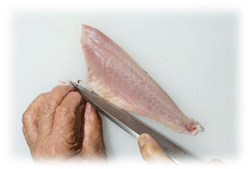 |
 |
| 3,Cut open the bottom of the belly bone all the way to the end and remove the belly bone. | 9,Make seared sashimi from the lower body of the another fish. |
 |
 |
| 4,The lower body with the belly bones and small bones removed. | 10,Place the lower body with skin on ice and sear it with a burner. |
 |
 |
| 5,尾ビレ側から皮と身の間にInsert the tip of the knife between the skin and the fish meat from the tail fin side.を切り込む。 | 11,Seared lower body with skin |
 |
 |
| 6,Remove fish skin all the way to the head end and separate the skin. | 12,Sogitsukuri is done in the left position, but because there is a lot of fat under the skin, the skin peels off, making it difficult to cut it into a nice shape. |
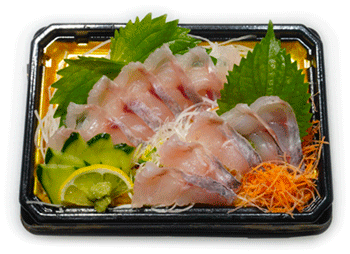 |
|
| This sashimi has 7 slices on the top left without skin, and 5 slices of aburi on the bottom right. | |
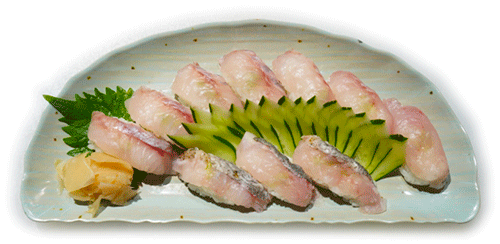 |
|
| The top seven pieces of nigiri sushi are skinless, and the bottom three pieces are seared. | |
Japanese bluefish are no less than blackthroat seaperch
I found Japanese bluefish to be delicious no matter how it was cooked. In any case, this fish has a high level of quality as a cooking ingredient. When you hear the name of the fish called Japanese bluefish (Japanese name kuromutsu), you probably automatically think of the blackthroat seaperch (Japanese name akamutsu), which is famous throughout the country for its deliciousness.
The blackthroat seaperch (akamutsu) and the Japanese bluefish (kuromutsu) are similar in shape, but they are basically classified as different fish, not just because they are red or black. The Japanese bluefish is a member of the genus Scombrops in the family Scombropidae, while the blackthroat seaperch is a member of the genus Doederleinia in the family Acropomatidae.
Since this is the case, let's compare the images.
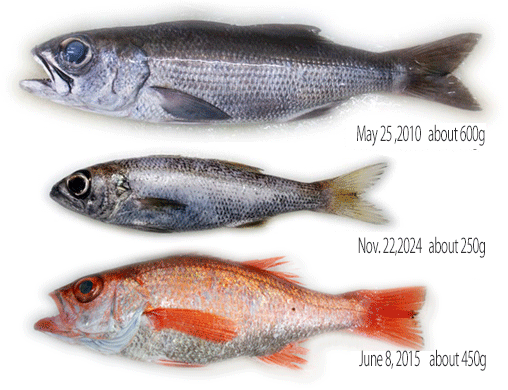
Comparing the Japanese bluefish and blackthroat seaperch in the image above, the Japanese bluefish is slender and slimmer, while the blackthroat seaperch is taller and rounder than the Japanese bluefish. Although they look similar, it is clear that they are different species of fish, and anyone can understand that they are not brothers or anything.
The weight of the blackthroat seaperch I handled 10 years ago was approximately 450g, so I think this is definitely true. This is because this is one fish extracted from the following images.

The styrofoam box in which this blackthroat seaperch was placed had the following markings on it.

This photo was taken of a blackthroat seaperch that arrived on June 8, 2015, in the fresh fish section of a supermarket in Tsushima City, Nagasaki Prefecture, where I have been instructing the fisheries department for the past 14 years. I don't remember much about the purchasing cost, but I remember that just because it was produced in the region it wasn't necessarily extremely cheap, and it was a reasonable price befitting a blackthroat seaperch.
If you compare Japanese bluefish and blackthroat seaperch and express the difference in fat on a sensory level, blackthroat seaperch has a thicker fat. I also felt that the Japanese bluefish had a well-balanced overall distribution, and seemed to be thinner than the blackthroat seaperch.
Japanese bluefish and blackthroat seaperch have the same name, mutsu. I already mentioned above that this is derived from the plumpness of the fat, but both are fish species that belong to different families whose fat makes them distinctively delicious. In general, blackthroat seaperch may be more highly rated due to its beautiful red appearance, but I would like to emphasize that Japanese bluefish is in no way inferior to blackthroat seaperch in terms of taste.
As the cold season approaches, Japanese bluefish will gain more fat and become more delicious. When the spawning season comes around in spring, the fish eggs, called mutsuko, become highly valued. Considering that the larger the fish roe gets, the more fat it absorbs into the fish's body, customers should try Japanese bluefish in the middle of winter when the roe has not yet fully grown.
| Please access the following URL if you want to secure using SSL. All pages in the site will be secure pages. |
https://secure02.blue.shared-server.net/www.fish-food.co.jp/message english 12.2024.html |
An opinion and the communication are to iinfo@fish food times
Date of updating 1 Dec. 2024
